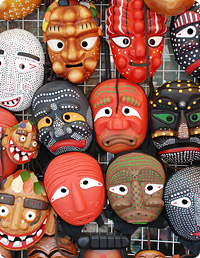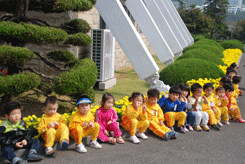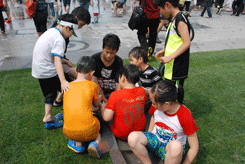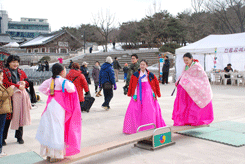Life
Dreams of Conception
Since ancient times, certain dreams have been perceived as signs of conception. Quite often these dreams were interpreted to predict the gender of a baby or even its fortune. A big animal or plant was usually regarded to foretell the birth of a boy, whereas a fairy a flower or a hairpin was considered the symbol of a girl. A tiger stood for a brave general, while a crane, a dragon or a phoenix represented a man of prominent scholarship for high social status.
Samsin
The birth grandmother (Spirit) oversees conception, birth, and lactation. She takes the infant as her special charge in the immediate postnatal period. In Andong, the birth grandmother resides in the inner room. Men claim their ritual space on the open porch. These separate spheres reflect the traditional Korean dichotomy of husband and wife, the outside person and the one inside. To induce conception in an infertile woman, the Mansin coaxes the Birth Grandmother into a gourd dipper filled with rice grain. Offerings to the Spirit include seaweed soup and cooked rice on a table on the seventh day, the fourteenth day, and the twenty-first day after childbirth. In this community people refer to the Birth Grandmother as Samsin. Some people believe that the Spirit is the great grandmother of the newly born child.
In the past, babies were usually born at home with the help of a midwife. However, especially for the first born child, expecting mothers would go to her own mother's house for more emotional support and better care after the delivery. Nowadays, more women have their babies delivered in hospitals. In the older days, people used to hang the so-called Forbidding Rope, a straw rope woven with pine branches, charcoals and red peppers for a boy, and just pine branches and charcoal for a baby girl across the gate to indicate the birth of a newborn child. The rope would hang for 3 weeks for a boy and a week for a girl. This was to forbid the entry of non-family members, for superstitious and hygienic reasons. In the days of high infant mortality rate, the 100th day after birth was an occasion well worth celebrating. Numerous guests were invited, and parents also presented rice cakes to neighbors. On the first birthday of a child, a formal celebration table is set, with cookies, cakes, and fruits. Parents would also place a hank of yarn, money, and stationery etc. on the table. If the child reaches out for money, it was believed to mean that he or she will grow to be rich; if the child grabs the yarn, he or she would enjoy longevity; Stationeries denotes that he or she would grow to be a scholar. It was not all that seriously believed, and it was sometimes of a game, but later events were often interpreted in the light of this choice. That proceeding was followed by a big feast and, in modern times, the inevitable picture taking. Koreans married early in the old days, and sometimes pre-teen children were given in marriage. So, childhood was regarded rather as a period of preparation for adulthood, and children were not, as a rule, indulged. Commoner's children helped their parents with their work.
Taboo Line
When a baby was born, a special straw rope called Geumjul was hung across the gate of the house to announce the birth together with a gender. For a boy, the rope was inserted with red pepper and charcoal. For a girl it had charcoal and pine twigs. The rope was believed to drive away evil spirits and any impure visitors. It was removed 21 days later.
Longevity pray
Ceremonies for the newborn child again involve a sequence of rites of separation, transition and incorporation, in which the grandmother of the child attempts to sell her grandson to a designated rocks or trees in an animistic rite of separation. If the child was born in the year of the cow, he may be sold to the grass field; if the child is a dragon, he may be sold to the well in the house, if the child is a tiger, his grandmother would sell him to a large rock in the mountain. Magico-religious practices and rites are a series of acts to ensure the health and long life of the year-old child and facilitate the separation from his cradle.
Dol (The First birthday)
The first birthday celebration, referred to as Doll in Korean, accompanies a feast for the child and the Birth Grandmother. Family and guests eat a meal together, then the child is placed on a cushion or on a chair for the first time. Early in the morning an offering is made to the Birth Spirit with gifts and food. When the ceremonial offerings performed by the child’s grandmother are over, a table full of food is brought into an inner room in front of the child. All kinds of pastry and sweets, cooked rice, seaweed soup, fried fish or different kinds, and fruit dishes, together compose a typical birthday table. Symbolism is involved with the foods. The child takes an active part in all rites performed before the Birth Grandmother he is made to move his hands, and so forth. In this connection, the future career of the child is predicted, several toys representing tools of different occupations are placed before the child, and the one which he picks up first is taken as an indication of child’s future character, profession, and social status. If the child picks up a writing brush, he/she will probably be a writer and a set of bow and arrows implies a professional soldier. In addition to expressing good wishes, guests also give presents such as a gold ring, clothes, or toys.
Baegil (100-days)
It celebrates the cycle of life, and symbolizes the beginning of life that is the first of many events one will go through. It takes place after 100 days after the birth. Family members give thanks to Samsin, the three gods who take care of the baby's life while growing up. Then, they pray for longevity and good luck for the baby. They prepare the feast, mostly comprising 4 types of Korean foods, each of which symbolize longevity, cleanliness and freshness, and ward off bad fortune. Family members, close friends of the family usually attend. It is celebrated at the family's home, or a fancy restaurant. This usually depends on the number of people attending. This is another opportunity for family and friends to come together and have fellowship.
Childhood
In the upper class, boys were educated in the Chinese classics, and girls in the skills and arts necessary for matrons. In marriage, primary emphasis was on the succession of lineage and prosperity of the family, not on the connubial happiness of the couple themselves. So, the choice of one's future spouse rested almost entirely with the parents. The wedding ceremony varied widely according to region, social status, and family convention, but in all cases, it was a colorful ceremony eagerly watched by the whole townspeople. The wrongs a Korean woman suffered as a daughter-in-law and wife were often compensated in her role as a mother. Once she became the mother of grown-up sons and had daughters-in-law, she could exact unquestioning and absolute obedience in her house. Thus, there was a perpetuation of oppression of women by women. Women's status was not so miserably low in Korea until mid-Joseon dynasty, when the Hideyoshi invasion upset the social order and drove the authorities to enforce strict Confucian codes to prevent social morals from disintegrating. Until the 16th century, daughters were given equal shares in inheritance, widows were allowed to re-marry, and wives had property rights. But from the 17th century, women were allowed no individuality, and the only way a woman could become respected was to excel in the Confucian virtues of chastity, tolerance, endurance of hardships, and self-sacrifice for others. The analysis of ceremonies accompanying an individual's life crises which Van Gennep called 'les rites de passage' is considered to be an important contribution to the understanding of rites. The various rites of protection against the evil eye, infections, diseases, all kinds of evil spirits, and so forth, are beneficial simultaneously to the mother and the child; where they pertain particularly to the child, they do not differ significantly from other practices of the same sort. Giving second name to a new born child, a magical operation to ward off evil spirits is widely practiced in Korea. This can be interpreted as a rite of separation of a child from his mother, a ritual mechanism to overcome life crises of the new born child. These animistic rites have a direct meaning the children pass gradually from a dangerous world into one that is more favorable or neutral.
Coming of Age Ceremony
It is appropriate to distinguish between physical puberty and social puberty, just as we distinguish between physical maturity and social maturity. Membership in a given class is indicated by a person's name. A naming ceremony called "Gwallye", usually takes place between the ages 15-20. The ceremony consists of three parts, and a man of virtue and learning is invited to officiate, but it is now almost extinct except in some families in the Andong region. In the presence of elders representing their clans, they went through elaborate procedures of tying their hair in a topknot putting on a set of formal headgear, including a black hemp hat, the Confucian student's cap and a wide-brimmed black horsehair hat and receiving an adulthood name. Women wore a chignon fixed with a long hairpin for the first time for their coming-of-age ceremonies, usually held about the age of 15. For women, the wedding ceremony often replaced this ceremony. Today, the ceremony falls on the 20th birthday on the 3rd Monday of May.
Education
Joseon society aimed at setting high moral standards through ethical education based on Confucian teachings about basic human relations. The government distributed illustrated ethical books translated into the vernacular script and honored those who set outstanding examples as filial sons, royal subjects and faithful wives. The Joseon dynasty's highlights educational institution was Seongyungwan, national Confucian academy, which also served as the center of Confucian studies. On the secondary level were two kinds of schools; Hakdang in the capital Seodang carried out elementary education. Usually sons were taught in private village schools. Among the few wealthier families, it was not uncommon for a private teacher to be hired for group of households which contributed collectively to his salary, sending their children to him. Such a teacher was called Hunjang. One Thousand Chinese characters, the First Text for Enlightenment, and Text for Bright Mind were principal subjects, studied through reciting, writing, and calligraphy. Boy studied Chinese characters and ethics at private elementary schools. They continued their education for character development and preparation for the civil service examinations at local public schools or private Confucian academies. They studied Confucian classical texts, history books and astronomical charts. Women were taught ethics and the Korean script at home. They acquired information and knowledge by exchanging correspondence or reading books translated into Korean.
Eldest son
Children, especially the eldest son, have a strong obligation to parents who must be honored and heeded Ancestor worship is also extremely important in Korea and seen as a way to try and pay back some of the debt children owe to their parents. Chuseok and New Year's Day are two particular occasions where previous generations are remembered.
Filial piety
Filial piety among family members was considered a vital moral concept in the Confucian-oriented Joseon society. Koreans still place great emphasis on filial piety to parents and ancestors, fidelity to spouse and faithfulness to friends, although loyalty to the ruler and respect for teachers appear to have more of less lost their reigning importance among the five most esteemed ethical values in traditional society. The family line, which continued from father to son, demanded absolute filial devotion on the part of the son. The faithful observance of ancestral rites and the three-year mourning period epitomized filial duties. The head of the family therefore bequeathed his eldest son with the obligation to observe all ancestral rites as well as his property. He also compiled a genealogical record to define the family pedigree and relations among relatives. His wife managed household affairs and prayed for the peace and wellbeing of her family by making embroidery decorated with auspicious patterns.
Calligraphy and painting
The literati of Joseon considered it their great success in life to join public service through cultivating their academic ability. They also believed that a cultured gentleman must excel in all of the three arts of poetry, calligraphy and painting. They enjoyed outdoor meetings at scenic locations where they composed poems or painted the landscape while appreciating one another's skills. They made albums with paintings and calligraphic works thus produced to commemorate such meetings.
Life and art at the royal court
The elegant and refined way of life at the royal court was the impetus for the production of the arts during the Joseon dynasty. The clothes, food and furniture used at the court were made by the most renowned artisans using the best materials available and they symbolized the splendor and dignity of the royal family. In this way, not only did they serve a practical purpose but they also had the important function of symbolizing the supreme authority of the monarch. For this reason, furniture and other artifacts were made exclusively for the royal family and were not allowed to be used by other members of society. However, the courtly style greatly influenced the making of objects used by those outside the royal palace.
Royal childbirth and the court education
Since the eternal prosperity of the kingdom depended on the continuous existence of benevolent rulers, enormous efforts were placed upon the role of securing the dynastic lineage and educating potential rulers. Fetal education began as soon as a royal pregnancy was confirmed. A special room and rituals were organized near delivery for the health and safety of the new-born baby. After birth, the umbilical code and placenta were preserved with utmost care. Amongst all royal descendants, the highest expectations were placed upon the crown prince, in traits such as personal character, social skills and insight. He was also required to excel in literature, art and martial arts to realize his vision.
Royal arts and scholarly culture
Neo-Confucianism, the philosophy that formed the base of the Joseon dynasty, encouraged the intellectual activities. Thus the king was tutored by the most renowned scholars in the kingdom, and respected as a divine ruler and an authoritative scholar, whose literary and calligraphic skills were essential for both delivery and expression of his ideas. A lot of Joseon kings were renowned artists as well as patrons, collectors and connoisseurs of precious artifacts, paintings, calligraphy and seals. Due to their efforts, Joseon dynasty developed a remarkably high level of art and literature, up to which the kings and the elites strived not only to cultivate themselves but also to encourage it to the whole society.
Korean Medicine Clinic
Traditional Korean medicine clinics provided healing services combining pharmacology, acupuncture and moxibustion. Then, in the early 17th century, the compilation of Exemplar Korean Medicine, based on ancient Korean and Chinese treaties, initiated epochal progress in medical science. Many clinics applied the new local theory dividing the constitution of human body into four different types. Acupuncture and moxibustion came to be widely applied along with herbal medicine. When these therapies did not work, people often resorted to supernatural powers. To cure or prevent diseases, shamans were invited to perform exorcism or prescribe talismans.
Acupuncture
Acupuncture is a method of medical treatment widely popular in Korea. It cures ills by inserting small metal needles in specific parts of the human body. According to Oriental medical science, a human body consists of interconnected body parts and relies heavily on their harmony. They must remain strictly harmonized in order to maintain good health. If any part-big or small-fails to preserve harmony, the human body will surrender to disease and display various signs of illness. The pathways in the body along which vital energy flows from the head to the legs, chest, and arms is known as "Gyeonglak,'' while the meeting point of this vital energy is called "Gyeonghyeol.'' According to acupuncture, the energy that flows through the body stagnates at patients' Gyeonghyeol. Stimulating numerous other points with needles improves the flow of "Gyeonglak'' to cure the illness. This form of Oriental medicinal science is being used to treat various chronic maladies such as migraines and pain in body parts such as joints, shoulders, and the waist. Today, most oriental clinics use acupuncture.
Jeom (Fortune-telling)
It is a way to judge by magic or occult power that which is beyond the ability of human beings. It uses various methods for avoiding misfortune and escaping from an unfavorable condition by foretelling what will come in the future or finding out what is beyond the intellectual power of human beings. The kinds of Jeom are almost countless, Jeom by observing natural or heavenly phenomenon, and Jeom by means of the science of divination, which is called philosophy in a vulgar sense. The Sinjeom is the kind of fortune-telling to which Jeom in Korea mostly refers. It is the process in which a Jeomjaengi, a fortune-teller, said to be possessed by a spirit or a god, speaks about the past or the future of a client. Jeom shows a possible direction to these people and gives consolation to them so they can go on with their lives.









